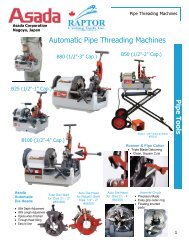March 2006 - Plumbing & HVAC
March 2006 - Plumbing & HVAC
March 2006 - Plumbing & HVAC
You also want an ePaper? Increase the reach of your titles
YUMPU automatically turns print PDFs into web optimized ePapers that Google loves.
Shop ManagementSuccessionplanningGetting business in order is a key first stepBy Ron ColemanNow that you aregetting older (andhopefully richer)the thoughts of packingit in are becoming morefrequent. All your friendsseem to be either dying or retiring andyou can’t afford to do either. Yourthoughts turn to succession planning.One hundred and thirty-five thousandsmall and medium business ownersare expected to exit their businesses overthe next five years, reports the CanadianFederation of Independent Business.Construction-related businesses areamong the most difficult to dispose of.The choices you have are:Wind it down• Sell it to family membersor to employeesSell it to a third party• Install senior management andgradually retire (There are many companiesthat are operated by professionalmanagers with little or noowner involvement)Wind it downSurprisingly enough, winding down acontacting business is more difficult thanit first appears. It is easier to get into businessthan out. Your customers won’t paytheir accounts if they know you are windingdown because they worry about theirwarranty. Therefore you may have to keepsome structure in place for at least oneyear after you cease operations in order tocollect your money. You will likely alsohave to provide some process for doingwarranty claims.Also, when you sell off your inventory,tools and equipment, you tend to get alot less than you expect. If you decide towind it down be prepared to take somehits. For many people, winding down abusiness that they have spent their lifebuilding up is very traumatic.Why is this man smiling?Reason # 9InformationThere are two ways to keep up-todatewith industry changes.The hard way takes time, moneyand energy. The easy way takes anHRAC membership! Membershipmeans your company will receivecurrent and accurate industry informationon a wide variety of topicsincluding regulatory and codechanges, utility issues and industrydevelopments.So, why is this man smiling?Because his company is amember of HRAC.You should be too!1-800-267-2231 www.hrai.ca/hrac.htmlSell to family or employeesSelling the business to family or employeesis often a realistic manner of disposingof the business and of helping outfamily and long-term employees. It doeshave some major downsides; usuallythese people have little or no cash andthey want to pay for the business out offuture earnings. There are ways of dealingwith this and I will address themshortly.Sell to third partySelling to an independent third party isoften the most lucrative way to go, particularlyif you can get a competitor tobuy. They have strategicreasons for buyingand often have cashresources or security.The fees to a sellingagent can be high fora small business. Wewill address this strategyin an upcomingarticle.But, maybe we areputting the “cartbefore the horse”.The real question is: why would anyonebuy my company? The owner needs tomake a list of saleable assets, includinggoodwill. Approximately 60 to 70 percentof contracting companies makeless than five percent pre-tax operatingprofit. There is virtually no goodwill inthese companies as they are operatingat a level that a new entrant can easilyachieve; these companies are onlyworth book value.So, now you need to identify what aprospective buyer wants and build yourcompany accordingly. If mostof your work is won on theopen bid market you have littleto sell. If most of yourwork is negotiated by yoursales and estimating team,you may have a little goldmine. If you do service workand have healthy revenuefrom planned maintenanceprograms and lots of repeatclients, you also have asaleable asset. If your keyemployees have been withyou for a while and want tostay with the company, youhave another little nugget.Finally, if you have systemsand processes that make yourbusiness run along the linesof a franchise, then you areshowing that you have built abusiness rather than boughtyourself a job.However, unless you can back awayfrom the business without having anegative impact on the business’ performanceyou will find it very difficultto sell. Spend the next five years buildingyour business into a real businessunit that operates without your everydaypresence. Then you will havesomething to sell.If you do put the business on thisindependent footing, you will also havegreater security for any financing thatyou have to provide to the purchasers.For many people,winding down abusiness that theyhave spent their lifebuilding up is verytraumatic.An exampleLet’s try this as an example. (See the balancesheet in Fig. 1)This company has a book value of$225,000. If the owner could liquidate itand get paid out that’s what he wouldhave left. If a husband and wife ownedthe business, they could draw a net of$48,000 in dividends without attractingincome tax. All other income would gostraight to the next level of income tax.If they sell the business to theemployees or family they should followa different procedure. Form a new companythat the employees/familywouldown. Loan the newcompany some workingcapital, taking theaccounts receivable assecurity. They wouldlease the equipmentto the new companyand, if the lease paymentswere met foran agreed timeframe,ownership of theequipment would pass to the new company.If the new company failed, thenthe equipment still belongs to the oldcompany and the security against theaccounts receivable can be triggered.The new company can pay consultingfees to the owners of the old company(to cover “goodwill”).This process will work provided thenew company is a viable entity and themanagement has been trained properly.This is the difference between delegationand abdication.FIG. 1: AN EXISTING BUSINESSBALANCE SHEET$ThousandsCurrent AssetsAccounts receivable 200Inventory 50Total Current assets 250Fixed AssetsEquipment 150Total assets 400Current LiabilitiesAccounts payable 100Bank 75Total Liabilities 175EquityRetained Earnings 225Liabs & equity 400Give yourself plenty of time. Fiveyears is not unrealistic to put the structurein place to make the business avaluable entity. Talk to your advisorsabout putting a plan in place. Developyour business blueprint and build it likeyou would any other project – one stepat a time.Ronald Coleman is an accountant,business management consultant, authorand educator specializing in the constructionindustry. He can be reached atrcoleman@coleman.bc.ca.Circle Number 166 for More Information62 <strong>Plumbing</strong> & <strong>HVAC</strong> Product News – February/<strong>March</strong> <strong>2006</strong> www.plumbingandhvac.ca
















